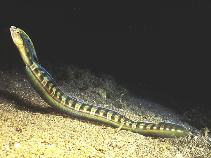| Family: |
Blenniidae (Combtooth blennies), subfamily: Blenniinae |
| Max. size: |
53 cm SL (male/unsexed) |
| Environment: |
benthopelagic; marine; depth range 2 - 1190 m |
| Distribution: |
Indo-West Pacific: Red Sea and False Bay, South Africa to Vanuatu, north to southern Japan, south to Australia. |
| Diagnosis: |
Dorsal spines (total): 13-14; Dorsal soft rays (total): 105-119; Anal spines: 2-2; Anal soft rays: 107-119. Easily distinguished from other blennies by an extremely elongate body. Dorsal fin origin above eye. |
| Biology: |
Adults occur on open soft-bottom and mud habitats from shallow bays to deep water. They are found in tube-like burrows in sand or mud bottoms (Ref. 9710). Very rarely encountered but more usually seen at night (Ref. 90102). Nocturnal feeders. Stomach of two specimens trawled in 50-54 m off western India contain crustaceans (including copepods), polychaete remains, forams, fish scales, and some sand and mud (Ref. 11441). Oviparous. Eggs are demersal and adhesive (Ref. 205), and are attached to the substrate via a filamentous, adhesive pad or pedestal (Ref. 94114). Larvae are planktonic, often found in shallow, coastal waters (Ref. 94114). Have eel-like bodies but are rarely seen swimming away from their burrow (Ref. 48636). |
| IUCN Red List Status: |
Least Concern (LC); Date assessed: 28 March 2009 Ref. (130435)
|
| Threat to humans: |
harmless |
Source and more info: www.fishbase.org. For personal, classroom, and other internal use only. Not for publication.

